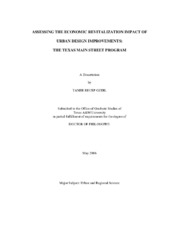| dc.description.abstract | The relationship between urban design and economic activity is seldom studied through
empirical studies with a large number of cases due, in part, to the implicit and intangible
nature of design. This study was intended to understand, analyze, and evaluate the
complex relationship between the design and the economic revitalization of downtown
districts with reference to the 78 active Texas Main Street Program districts. First, the
design, promotion, organization, and economic restructuring components of the Main
Street Program's comprehensive four-point approach were investigated. Next, the
economic changes that occurred within those districts were analyzed from 1997-2001.
Finally, employment, the number of jobs, the number of business establishments, the
number of sales tax permits, the retail sales volume, and the commercial property values
were compared for the same time period among three categories of cities: those active in
the Main Street Program, those formerly active but now inactive, and those who have
not participated.
Findings revealed that several positive changes occurred in design, promotion,
organization, and economic restructuring components of the four-point approach within the active Texas Main Street districts. It appears that these changes produced several
positive outcomes for the physical, social, and economical environment of the active
Main Street districts. Moreover, the findings suggests that these changes in the Main
Street districts resulted in an increased economic activity, not only within the Main
Street district by generating jobs, or producing private and/or public investment, but also
across the Main Street city by creating community wide economic activity in most of the
variables that were under investigation. The results indicate that the Texas Main Street
Program, part of which is urban design oriented, is having a positive effect on economic
activity within the active Main Street districts. | en |


